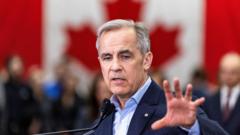The Canadian government confirmed that discussions are underway to explore the feasibility of joining the Trump administration's ambitious Golden Dome missile defense initiative. Designed to protect against "next-generation" aerial threats, this system is projected to have significant financial implications, with initial estimates hovering around $25 billion, although some analysts suggest total costs could escalate to $542 billion over two decades.
Prime Minister Mark Carney's office has emphasized the importance of these talks in light of recent trade and security tensions with the U.S., particularly following Trump's rhetoric suggesting Canada might be better off as an American state. Carney, who recently secured a strong mandate from Canadian voters, is keen on establishing a comprehensive security framework alongside economic stability within the region.
On a recent visit to Washington, Trump reiterated that Canada has shown interest in the Golden Dome framework and acknowledged its right to pursue its own national defense. While both nations have cooperated on NORAD, established in 1958, these latest discussions aim to modernize and expand their mutual defense capabilities, especially as threats from aerial weaponry evolve.
The Golden Dome system aims to integrate advanced technologies, including space-based sensors, to intercept high-speed missiles, drawing inspiration from Israel's successful Iron Dome initiative. However, skepticism persists among defense analysts regarding the feasibility of executing such a complex system across the vastness of U.S. territory, raising questions about potential effectiveness and readiness before the end of Trump's current term.
Experts like Shashank Joshi caution that while the U.S. military may take the Golden Dome initiative seriously, the prospect of its swift implementation and adherence to budget constraints may be overly optimistic. As Canada contemplates its role in this considerable defense endeavor, the discussions are reflective of broader themes around national security, economic partnership, and the geopolitical landscape of North America.






















